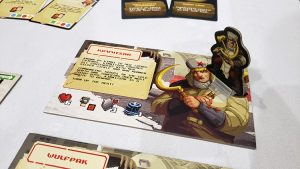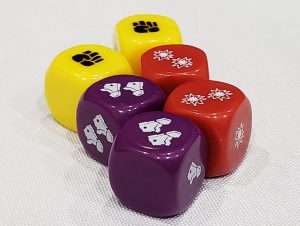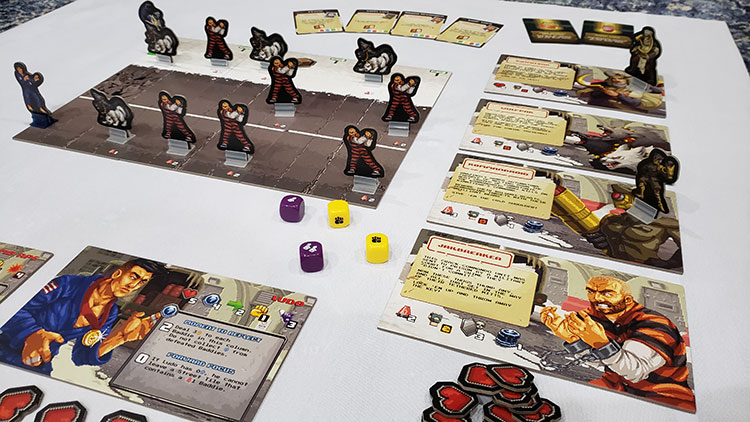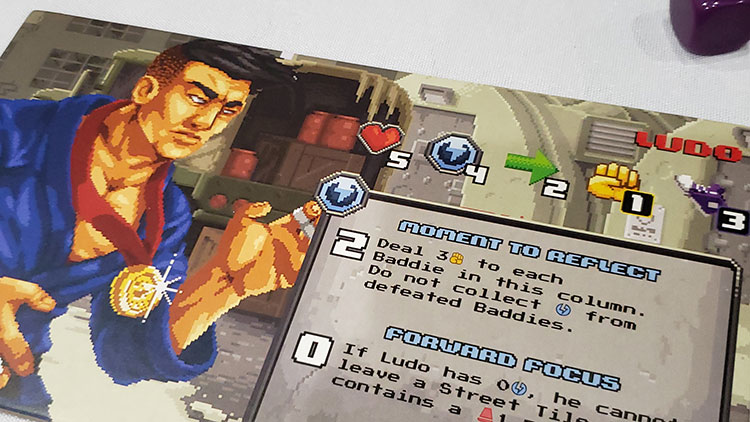 Enjoying a game’s theme is always something to look forward to. From the exciting experiences you’ll have in the 18th century to the fast-paced exploration through the Seven Seas, you’ll find a story that’s right for you.
Enjoying a game’s theme is always something to look forward to. From the exciting experiences you’ll have in the 18th century to the fast-paced exploration through the Seven Seas, you’ll find a story that’s right for you.
Streets of Steel is a ‘side scrolling’ cooperative board game based on 80’s style arcade fighting games. If you’ve played Double Dragon or X-Men “back in the day”, you might like Streets of Steel. It’s playable solo or with 2-4 buddies and plays in about half an hour to 45 minutes.
Gameplay Overview:
The board is made up of three Street tiles, allowing for the game to scroll through various sections, by removing the leftmost tile and adding a new one to the rightmost area. Each one has three rows and three columns that create 9 spaces for figures to stand. Several Baddies (enemies) will spawn based on the Danger Level within various spaces, and each Danger Level, indicated by a number, indicates a different Baddie, with the higher Danger Levels being more deadly than the lower.

On each player’s turn, they take three actions (in any order):
- Move – Advance spaces equal to your character’s move distance.
- Attack – Attempt to damage a baddie that is in your space, unless otherwise noted.
- Use a Super Ability – Activate your character’s special ability. These can be either fighting-based or non-fighting-based.
You may also spend an action to gain one Energy, which is used to activate Super Abilities.
Moving out of a space containing a Baddie causes that character to be attacked by the corresponding enemy. Baddies will attack with a specific die depending on their danger level. When a player attacks, the symbols on his/her character show what type of dice to roll.

Danger (red) Dice are unpredictable and extremely random, Kick (purple) Dice are less accurate but more powerful, and Punch (yellow) Dice are the most accurate but do low damage. Instead of having health, Baddies have a defense rating. It shows how many hits are required to defeat the Baddie. Of course, Higher Danger level Baddies have a higher defense.
After all players have taken their turns, the Baddies activate. A card is drawn, and if the specified type of enemy is in play, all figures of that type in play activate with parameters based on what is printed on the card.
Once the board scrolls to the last tile, the Boss Baddie spawns. It acts similarly to how the player’s characters function and has a health rating as well as a defense. If the Boss Baddie is defeated, the players win. If the heroes die a certain amount of times, the players lose.

Gameplay Experience:
Because of Streets of Steel’s appearance, it comes across well for new players. The rules are easy to understand and can be taught in less than five minutes, which makes getting ready to play simple. Streets of Steel’s rules are laid out very well for referencing rules during the game.

Additionally, Streets of Steel’s representation of its theme is excellent. All the elements in the game show resemblance to their 80s counterparts and the enemies resemble what arcade machines would feel like. This gives an understandable feel to the game, which only games with well-produced themes have.
However, Streets of Steel’s replay value is where it is lacking. The game doesn’t take long to finish, and it doesn’t seem very different between playthroughs. The street tiles are very limited. Only a few extras are added per type, and not much variety is shown in each one. The baddies also seem to attack in almost the same way every time, which really waters down the different fighting styles of the different enemies.
Streets of Steel also comes off as a bit of an easy game. It seems very hard for players to lose even on Medium difficulty. Hard difficulty is challenging but doesn’t add anything that would make the game any different, it just tries to kill you off faster. The game doesn’t make decisions more difficult.

Final Thoughts:
Streets of Steel is a good game for players that want a throwback to their joystick jockey (quote my dad) favorites from the arcades. However, avoiding a sprained wrist by losing the joystick means accepting repetitive gameplay. If you want to buy a game that best represents the 80’s arcade theme, Streets of Steel is for you.
Final Score: 3.5 Stars – Streets of Steel has a fantastic theme, but the game may come across as dry the second or third time playing.
 Hits:
Hits:
• Well Executed Theme
• Simple; good for new gamers
Misses:
• Lacking Replayability
• Simple Choices






















I’ve gotta say, this is a well thought out review. Clear, concise, and it approaches the game from the perspective of the target audience–namely, people who likely played side-scrolling video games from yesteryear.
The use of photography to illustrate the points made by the review was very efficient as well.
You did a great job highlighting both the strengths and weaknesses of the game without coming off as biased, allowing the reader to decide whether to look into the game further.
Keep up the great work, I look forward to seeing more of your reviews in the future 😊
Great review, Samir. I was honestly surprised when I got to your profile. Up to that point, I was under the assumption that I was reading a good review from a seasoned writer (Not to say you’re not seasoned. You may have been writing since you were three. But you know what I mean) All that is to say, great job here! Looking forward to more reviews.